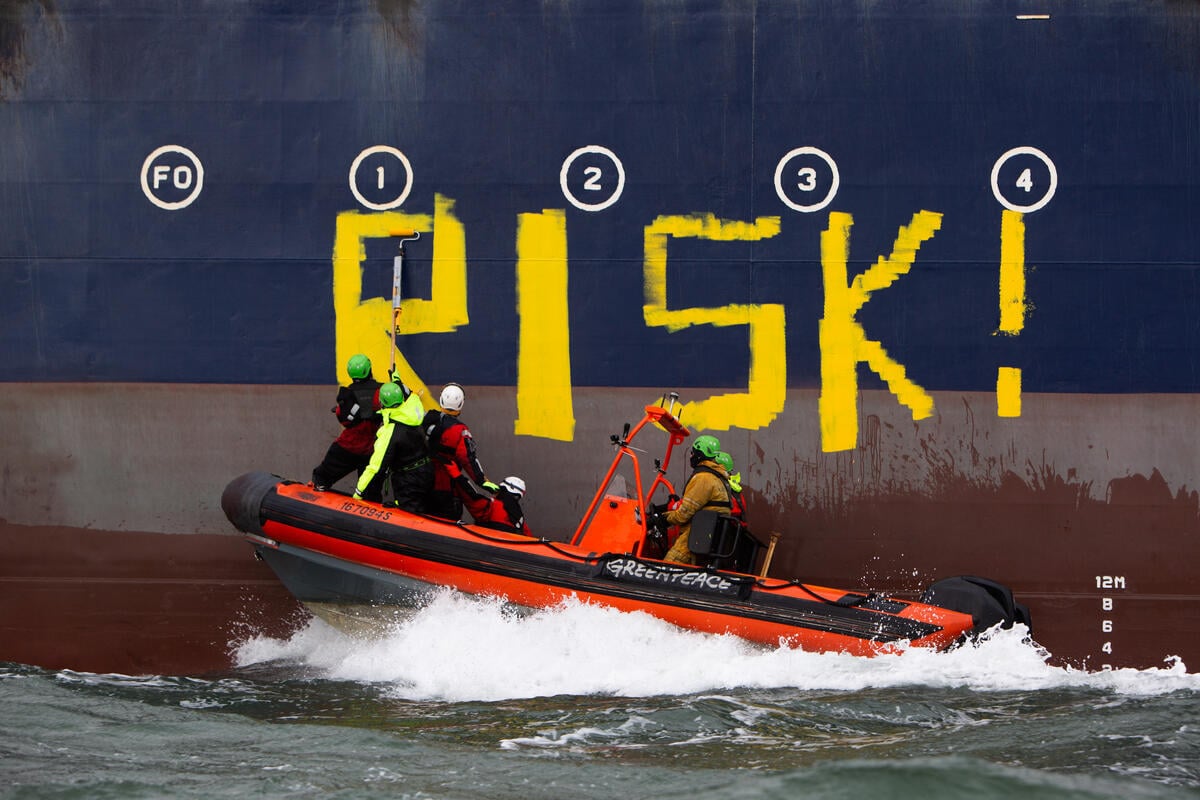Tokyo, Japan – Greenpeace Japan’s latest extensive radiation survey has found evidence of recontamination caused by 2019’s Typhoon 19 (Hagibis) and Typhoon 21 (Bualoi), which released radioactive caesium from the forested mountains of Fukushima Prefecture.
The survey, which was conducted over three weeks in October and November of 2019, observed concentrated radiation levels throughout Fukushima Prefecture. These localised areas were where radioactivity was observed at higher levels than in previous years, as well as a reduction in levels in some areas, and recontamination elsewhere.
The survey identified high-level hotspots throughout Fukushima Prefecture, including in Fukushima City. This ongoing and complex radiological emergency in parts of Fukushima Prefecture runs directly counter to the narrative of the Japanese government which continues to push its propaganda of normalization in Fukushima and the effectiveness of its massive decontamination program.
Typhoons no. 19 & 21 deposited large volumes of rain across Japan, including in Fukushima Prefecture. In recent years, scientists have been reporting the effect of heavy rainfall leading to increased migration of radioactivity from mountainous forests through the river systems.
“The results of our 2019 radiation survey demonstrate the complex and persistent nature of radionuclide mobilization and recontamination in areas of Fukushima Prefecture. The mountainous forest regions of Fukushima prefecture, which have never been decontaminated, will continue to be long-term sources of recontamination. The findings from our recent radiation survey definitively disprove the myth of a ‘return to normal’ in parts of Fukushima.” said Kazue Suzuki, Energy Campaigner of Greenpeace Japan.
The main findings of the Greenpeace Japan investigation include:
- Hotspots measured in all areas surveyed; including Okuma, Naraha (J-Village), as well in Fukushima City.
- Significant variations in radiation levels from previous years in certain zones that cannot be explained by radioactive decay.
- Likely remobilization of radioactivity in the soil and weather-related effects resulting from heavy rainfall was also identified in the reopened area of Iitate, with significant changes in radiation levels comparing across the five year period for which we have data.
- Along the Takase river in the newly reopened area of Namie, and where the government claims it is safe to live, 99% of radiation levels averaged 0.8 μSv/h with a maximum of 1.7 μSv/h, with 99% exceeded the government’s long-term decontamination target of 0.23 μSv/h measured at 1 meter and were twenty (20) times higher than pre-2011 levels.
- In a period of four hours, the survey team identified forty-five (45) hot spots in the around Fukushima City central station, eleven of which equaled or exceeded the Japanese government decontamination long term target of 0.23 μSv/h measured at 1 meter; including observed levels of radiation that 137 times higher than the background radiation levels measured in the Fukushima environment prior to the 2011 nuclear disaster.
- In an area close to a former school and kindergarten in the reopened area of Namie, annual dose rates would be between 10-20 mSv based on the Japanese government methodology and between 17-33 mSv based on sustained exposure over a full year; which are between 10 and 33 times above the international recommended maximum exposure for the public.
- Near the new town hall in the newly reopened area of Okuma, and within a few hundred meters of the planned Olympic torch route, radiation hotspots were measured to be of 1.5 µSv/h at 1 meter and 2.5 µSv/h at 10cm (62 times above the background levels of 0.04 µSv/h before the nuclear accident in March 2011).
- The evidence from earlier typhoons and resulting data strongly suggest that there was a substantial increase in downstream contamination from October 2019. Greenpeace intends to return later this year to further investigate and substantiate the hypothesis of major weathering effects in Fukushima.
“The radiation hotspots we found in public areas along the pavements and streets of central Fukushima City, including tens of meters from the entrance to the Shinkansen train line to Tokyo, highlight the ongoing scale of the nuclear disaster in 2011. The hotspots we found are at a level that they would require a special license to be transported and in the category of Dangerous Goods. The government is using the Olympics as a platform to communicate the myth that everything has returned to normal in Fukushima. They falsely claim that radiation has either been decontaminated or is under control. Our radiation survey clearly shows that the government propaganda is not true.” said Shaun Burnie, Senior Nuclear Specialist of Greenpeace Germany.
Mizue Kanno, a resident of Namie who cooperated on the Greenpeace radiation survey said, “I hope the world knows the real situation in Fukushima. Radioactivity is washing down from the mountains due to heavy rain and flowing into the decontaminated areas. The radiation levels found around my house are higher than ever before. Once a nuclear accident happens, it looks like this, and soon we are going to have the Olympics and pretend that everything is okay. It’s not. ”
ENDS
Notes:
Full report in English, here
Photos and videos, here
Contacts:
Shaun Burnie, Senior Nuclear Specialist, Greenpeace Germany
[email protected], +81 (0)80-3694-2843
Mitsuhisa Kawase, Communications Officer, Greenpeace Japan
[email protected], +81 (0)70-3195-4165
Greenpeace International Press Desk, [email protected], phone: +31 (0) 20 718 2470 (available 24 hours)



